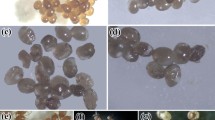Abstract
The toxicity of various extracts of Lantana camara L. leaves was investigated against Cadra cautella (Walker) eggs, larvae and adults. For eggs and larvae film residue method and for adults specimen tube method was followed, then it was compared with azadirachtin technical (20 %). The toxicity of various extracts on egg, larval and adult mortality was compared. The egg mortality was based on their hatchability. It was observed that through film residue, most of the extracts of L. camara showed higher mortality as compared to azadirachtin. Based on LC50 values methanol fraction of hexane extract (LC-3) and hexane extract of hexane fraction (LC-4) of L. camara were found to be most effective against different stages of C. cautella. The mortality was dose dependent and it increased with increasing concentration. The leaf extracts of L. camara were positively toxic to insects. The effects of various extracts on different stages of C. cautella are discussed.

Similar content being viewed by others
References
Gill JS, Lewis CT (1971) Systemic action of an insect feeding deterrent. Nature (Lond) 232:402–403
Teotia TPS, Tiwari GC (1971) Dharek drupes and leaves as protectants against S. cerialotta infesting wheat seeds. Bull Grain Technol 9:7–12
Ketkar CM (1976) Utilization of neem and its byproducts, modified neem cake manurial project. KVIC, Mumbai
Pandey ND, Singh SR, Tiwari GC (1976) Use of some plant powders, oils and extracts as protectants against pulse beetle. C Chinensis Ind J Ent 38:110–113
Attri BS, Prasad R (1980) Neem oil extractives as effective mosquito larvicides. Ind J Ent 42:371–373
Yadav SRS, Bhatnagar KN (1987) A preliminary study on the protection of stored cow pea grains against pulse beetle by indigenous plant products. Pesticides 21:25–29
Ayyangar GSG, Rao UJ (1989) Neem (Azadirachta indica A. Juss.) extracts as larval repellent and oviposition deterrents to Spodoptera litura (Fabr.). Ind J Ent 51:121–124
Dixit OP, Saxena RC (1990) Insecticidal action of Premina integrifolia against Callosobruchus chinensis (Coleoptera: Bruchidae). Pesticides 24:29–31
Gebbinck EAK, Jansen BJM, de Groot A (2002) Insect antifeedant activity of clerodane diterpenes and related model compounds. Phytochemistry 61:737–770
Isman MB (2001) Pesticides based on plant essential oils for management of plant pests and diseases. International symposium on development of natural pesticides from forest resources. Korea Forest Research Institute, Seoul, pp 1–9
Saxena RC, Dixit OP, Harshan V (1992) Insecticidal action of Lantana camara against Callosobruchus chinensis (Coleoptera: Bruchidae). J Stored Prod Res 28(4):279–281
Glolade AA, Adebayo TA (1993) Fumigant effects of some volatile oils on Callosobruchus maculates F. Insect Sci Appl 14(5):631–636
Adebayo TA, Glolade AA (1994) Protection of stored cowpea from Callosobruchus maculatus F. using plant products. Insect Sci Appl 15(2):185–189
Singh H, Mrig KK, Mahla JC (1996) Effect of different plant products on the fecundity and emergence of lesser grain borer, Rhyzopertha dominica in wheat grains. Ann Bio 12(1):96–98
Sedlacek JD, Weston PA, Barney RJ (1996) Lepidoptera and psocoptera. In: Subramanyam B, Hagstrum DW (eds) Integrated management of insects in stored products. Marcer Dekker, New York, pp 41–70
Jha AN (2003) Feeding propensity of Ephestia cautella and Trogoderma granarium to eighteen cultivars of wheat. Ind J Ent 65(2):228–232
Ahmed I, Mehmood Z, Mohammad F (1998) Screening of some Indian medicinal plants for their antimicrobial properties. J Ethnopharmacol 62:183–193
Pawar CS, Yadav TD (1982) Toxicity of organophosphorus insecticides against Cadra cautella (Walker) and Corcyra cephalonica. Ind J Ent 44(20):149–157
Finney DJ (1971) Probit analysis, 3rd edn. Cambridge University Press, London, p 333
Rao NS, Sharma K (2007) Ovicidal effect of seed extracts of custard apple on Corcyra cephalonica (Stainton) and Trogoderma granarium everts. Pestic Res J 19(1):4–6
Dwivedi SC, Garg S (2003) Toxicity evaluation of flower extract of Lantana camara on the life cycle of Corcyra cephalonica. Ind J Ent 65(3):330–334
Remia KM, Logaswamy S (2010) Larvicidal efficacy of leaf extracts of two botanicals against the mosquito vector Aedes aegypti (Diptera: Culicidae). Ind J Nat Prod Resour 1(2):208–212
Dwivedi SC, Karwasaria K (2003) Larvicidal activity of five plants extracts against Culex quinquefasciatus. Ind J Ent 65(3):335–338
Jaipal S, Singh Z, Chauhan R (1983) Juvenile hormone like activity in extracts of some common Indian plants. Ind J Agric Sci 53(8):730–733
Jaipal S, Singh Z, Malik OP (1984) Insecticidal activity of various neem leaf extracts against Rhyzopertha dominica a stored grain pest. Neem Newsl 1:35–36
Pandey ND, Mathur KK, Pandey S, Tripathi RA (1986) Effect of some plant extracts against pulse beetle, Callosobruchus chinensis Linnaeus. Ind J Ent 48:85–90
Acknowledgments
The first author acknowledges the Indian Council of Agricultural Research (ICAR) for providing financial assistance in the form of Senior Research Fellow (SRF) and to the Head, Division of Entomology, Indian Agricultural Research Institute (IARI), New Delhi for providing facilities to conduct the present study.
Author information
Authors and Affiliations
Corresponding author
Rights and permissions
About this article
Cite this article
Gotyal, B.S., Srivastava, C. & Walia, S. Toxicity of Lantana camara Leaf Extracts Against Almond Moth, Cadra cautella (Walker). Proc. Natl. Acad. Sci., India, Sect. B Biol. Sci. 86, 199–204 (2016). https://doi.org/10.1007/s40011-014-0438-0
Received:
Revised:
Accepted:
Published:
Issue Date:
DOI: https://doi.org/10.1007/s40011-014-0438-0




